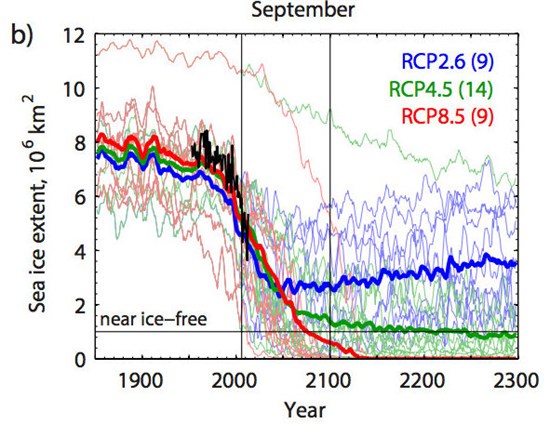Roz Pidcock
14.07.2014 | 3:30pmDiminishing Arctic sea ice is perhaps the most iconic consequence of climate change. And there’s a good chance we’ll lose it in summer before too long if emissions stay high, according to a new paper. But its demise is not a foregone conclusion – with a swift peak and decline in greenhouse gases we could still reverse that trend, the scientists say.
Losing ice
Arctic sea ice cover is declining by about four per cent per decade. But the seasonal low in summer is shrinking particularly quickly, at more like 11.5 per cent per decade.
At the other end of the planet, Antarctic sea ice is growing – but much slower than it’s being lost in the Arctic. We’ve written more about global sea ice loss here.

Arctic sea ice summer extent has decreased by between 9.4 to 13.6% per decade. Source: IPCC 5th Assessment Report, Summary for Policymakers
Previous studies have looked at the changing face of the Arctic this century. But a new paper is the first to use the latest generation of climate models to look as far out as 2300.
The prospect of sea ice-free summers has wide-ranging consequences. It would affect people and ecosystems, unlock new shipping routes and expose more fossil fuel reserves.
But an Arctic devoid of summer ice isn’t inevitable, the new study concludes. It’s still possible to reverse the decline, but the window is closing fast.
A chance for recovery
In its latest report, the Intergovernmental Panel on Climate Change (IPCC) laid out four pathways for how much warming greenhouse gases and aerosols could cause by 2100 and beyond. They’re not predictions, they’re just illustrations of how differently things could evolve.
In the lowest pathway – RCP 2.6 – the warming effect of greenhouse gases and aerosols peaks at around 2044, then starts to decline as policies to bring down emissions kick in.
Arctic sea ice responds quite quickly to the changes in forcing, as you can see in the graph below. The blue line showing sea ice extent in September falls to a low soon after 2044, and then rises slowly as the concentration of greenhouse gases in the atmosphere decreases.

RCP2.6 allows Arctic sea ice to recover (blue). The high emissions scenario shows sea ice free Arctic summers by around 2059 in the (red). Thick lines show the model average, thin lines are individual model runs. Source: Hezel et al. (2014)
By 2300, the study suggests if greenhouse gases peak and decline before mid-century the Arctic could recover on average 44 per cent of the ice lost between 1986 and 2005. Sea ice volume recovers a bit less over the same time, by 37 per cent. This suggests the ice isn’t as thick when it regrows, say the authors.
From a policy perspective, RCP2.6 is the only one of the IPCC’s scenarios that allows Arctic sea ice to recover. The scenario with the next lowest emissions – RCP 4.5 – sees greenhouse gases level off by about 2070. But that won’t be enough to allow recovery, says the study. In the graph above, RCP4.5 is the green line.
That’s because heat will continue to be released from the oceans even after greenhouse gases stabilise, meaning surface temperatures keep rising and sea ice keeps melting.
A question of timing
If emissions stay as high as they are – and we end up following the IPCC’s highest emissions scenario known as RCP8.5 – almost all the models predict the Arctic will become sea ice-free in summer this century.
But there’s a fair bit of disagreement about exactly when. The different models in the new study predict anywhere between now and 2077, with an average date of 2059 (thick red line in the graph above).
While they don’t agree on exact timing, climate models are pretty consistent on how much warming would tip the balance in favour of sea ice free summers. And it’s just 2.4 degrees Celsius above preindustrial temperatures, the paper says.
We’ve already seen 0.85 degrees since 1850 and scientists estimate even if greenhouse gases stabilised now, we’d still see temperatures rise by a few more tenths of a degree.
In all but two of the models, winter ice also disappears somewhere between 2134 and 2234. This is about equivalent to a temperature increase of 8.2 degrees Celsius, the paper finds.
As the new paper shows, Arctic sea ice in summer is likely to be a distant memory by 2300 if emissions stay high. But on the lowest emissions pathway, we can halt the decline and even see Arctic sea ice recover by nearly 50 per cent. So while models tell us how much warming is likely to push us into a seasonally sea ice free Arctic, how quickly we choose to get there is up to us.
Source: Hezel et al.. (2014) Modeled Arctic sea ice evolution through 2300 in CMIP5 extended RCPs. The Cryosphere. Doi: 10.5194/tc-8-1195-2014

